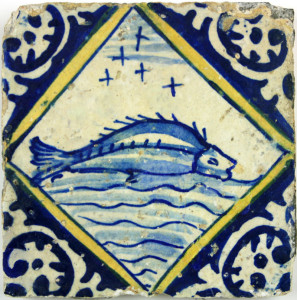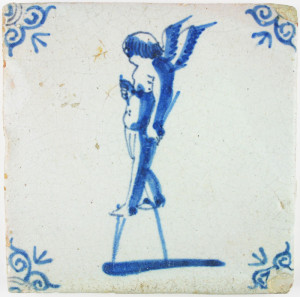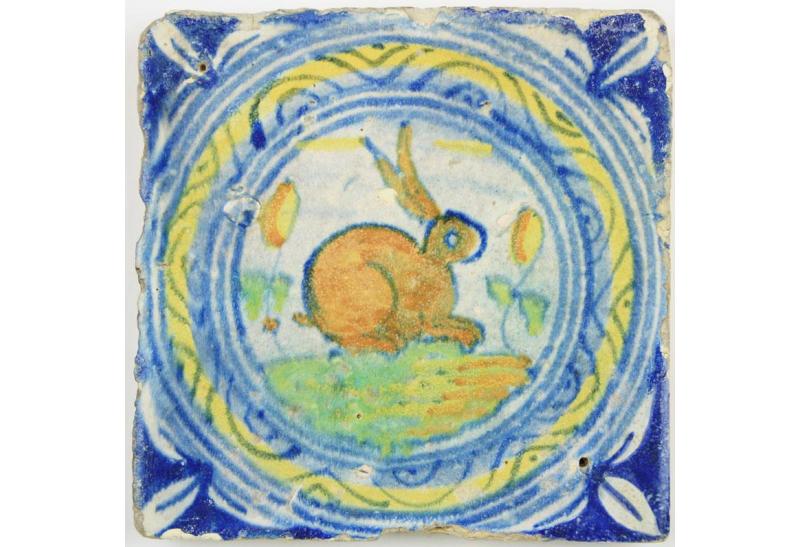It was at the beginning of the seventeenth century that the Dutch tile industry started to florish and rapidly became the largest production area of the world. It was not only known for the sheer size, but also recognized as the industry with the highest quality and diversity of products. Although tiles did not originate from the Netherlands and the Dutch did not have remarkable tile applications before the seventeenth century, the growth of the industry was the direct effect of an extraordinary period of economic and cultural flowering, eventually known as the Dutch Golden Age.
 The foundation of the industry was created by Italian craftsmen who had the knowledge and skill to produce tiles. Many of them had settled in the sixteenth century in the city of Antwerp, Belgium, at that time the most important (sea) port of the Low Countries. Many of them particularly moved to the Netherlands afther the Spanish conquest of Antwerp in 1585. At that same time, Dutch potters already had some success on their own with blue and white earthenware, mainly inspired by Chinese porcelain that was brought home from their overseas trips.
The foundation of the industry was created by Italian craftsmen who had the knowledge and skill to produce tiles. Many of them had settled in the sixteenth century in the city of Antwerp, Belgium, at that time the most important (sea) port of the Low Countries. Many of them particularly moved to the Netherlands afther the Spanish conquest of Antwerp in 1585. At that same time, Dutch potters already had some success on their own with blue and white earthenware, mainly inspired by Chinese porcelain that was brought home from their overseas trips.
Many middle eastern and southern oriented countries used tiles on floors or on the outside of buildings, as decoration or simply as a long lasting construction solution. The Dutch could not use tiles on the outside, as the winters were much colder and the tiles would only last for a few years. They had also seen that floor tiles were a vulnerable decoration whose glazed images got worn down over the years by many footsteps. They were looking for an application that would appeal a larger and broader group of customers. Eventually, they were successful.
The Dutch Delft tiles as we know them today, were at first created as wall tiles on the inside of fireplaces. Fireplaces had grown out to be real showpieces in the sixteenth century, but were marked by the eternally dark sooty hole. Wall tiles could very well handle the heat, were easy to clean and provided a bright and glistening sight for the family. It did not take long before more and more fireplaces were decorated with the most beautiful tiles, but it also did not take long before the Dutch noticed that the same wall tiles were also of great use on walls that were liable to humidity stains.
 As time passed the production process of the tiles improved significantly; the potters were able to make thinner tiles and became more and more efficient. With the same amount of clay as before, they were able to make more tiles and more tiles at once, reducing the amount of fuel required to keep their ovens running. Their market grew as well, as the Dutch trade, science, military and art were among the most aclaimed of the world and led to an significant increase of welfare across the country. Not only the rich in the cities were able to decorate their homes with tiles, also farmers and middle class families gained access.
As time passed the production process of the tiles improved significantly; the potters were able to make thinner tiles and became more and more efficient. With the same amount of clay as before, they were able to make more tiles and more tiles at once, reducing the amount of fuel required to keep their ovens running. Their market grew as well, as the Dutch trade, science, military and art were among the most aclaimed of the world and led to an significant increase of welfare across the country. Not only the rich in the cities were able to decorate their homes with tiles, also farmers and middle class families gained access.
More customers led to a higher demand of unique tiles, patterns and murals. The most exotic animals, sea creatures, flowers, mythological and biblical scenes were depicted on tiles and decorated the homes of their buyers. Nowadays, these tiles are true collectibles with many enthusiastic collectors all over the world. Prices range from a few to tens thousands of dollars, per tile.
The tile industry of the Dutch was globally leading for more than 200 years. During this time more than 800 million tiles were handmade. Not all tiles are collectibles, as many of them are re-used for modern decoration, restoration and design projects.
If you are interested in collectibles, wall tiles, murals or books with more information, please click any of these links.
Photos
- Top photo - This tile was made at the very beginning of the Dutch tile industry. It is a so called 'circle cord' tile that dates from around 1570 - 1590, so the 2nd half of the 16 century. It is very primitive in overall style, but shows many influences of Italian earthenware. It was made by the potters who still lived in Antwerp, or who had just left the city.
- Photo on the right - This tile dates from between 1590 - 1610 and belongs to the first series of wall tiles made by the Dutch. The primitive way the fish has been depicted, together with the overall thickness of the tile, clearly shows the influence of the Italian craftsmen who fled Antwerp and were mainly specialized in creating floor tiles.
- Photo on the left -Made around 1650, this tile is already quite a bit thinner than the fish shown above. Tile makers became more and more creative and answered the desire for extraordinary scenes, such as Cupid walking on stilts.

 10 out of 10
10 out of 10





